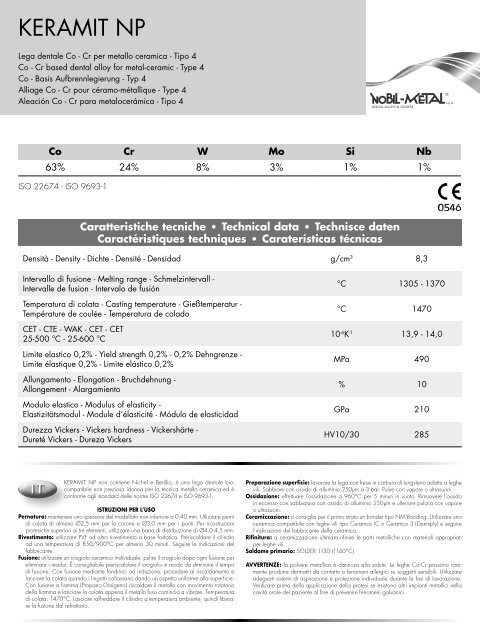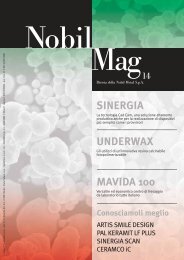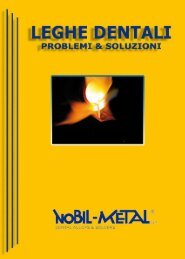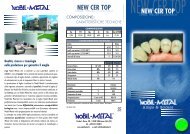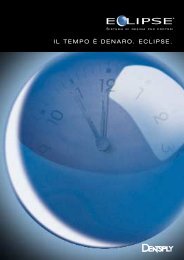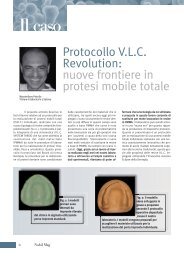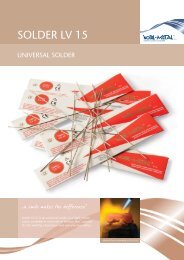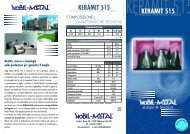KERAMIT NP - Nobil-Metal
KERAMIT NP - Nobil-Metal
KERAMIT NP - Nobil-Metal
You also want an ePaper? Increase the reach of your titles
YUMPU automatically turns print PDFs into web optimized ePapers that Google loves.
<strong>KERAMIT</strong> <strong>NP</strong><br />
Lega dentale Co - Cr per metallo ceramica - Tipo 4<br />
Co - Cr based dental alloy for metal-ceramic - Type 4<br />
Co - Basis Aufbrennlegierung - Typ 4<br />
Alliage Co - Cr pour céramo-métallique - Type 4<br />
Aleación Co - Cr para metalocerámica - Tipo 4<br />
Co Cr W Mo Si Nb<br />
63% 24% 8% 3% 1% 1%<br />
ISO 22674 - ISO 9693-1<br />
Caratteristiche tecniche • Technical data • Technisce daten<br />
Caractéristiques techniques • Caraterísticas técnicas<br />
Densità - Density - Dichte - Densité - Densidad g/cm 3 8,3<br />
Intervallo di fusione - Melting range - Schmelzintervall -<br />
Intervalle de fusion - Intervalo de fusión<br />
Temperatura di colata - Casting temperature - Gießtemperatur -<br />
Température de coulée - Temperatura de colado<br />
CET - CTE - WAK - CET - CET<br />
25-500 °C - 25-600 °C<br />
Limite elastico 0,2% - Yield strength 0,2% - 0,2% Dehngrenze -<br />
Limite élastique 0,2% - Limite elástico 0,2%<br />
Allungamento - Elongation - Bruchdehnung -<br />
Allongement - Alargamiento<br />
Modulo elastico - Modulus of elasticity -<br />
Elastizitätsmodul - Module d’élasticité - Módulo de elasticidad<br />
Durezza Vickers - Vickers hardness - Vickershärte -<br />
Dureté Vickers - Dureza Vickers<br />
IT<br />
<strong>KERAMIT</strong> <strong>NP</strong> non contiene Nichel e Berillio, è una lega dentale biocompatibile<br />
non preziosa idonea per la tecnica metallo ceramica ed è<br />
conforme agli standard delle norme ISO 22674 e ISO 9693-1.<br />
ISTRUZIONI PER L’USO<br />
Pernatura: mantenere uno spessore del modellato non inferiore a 0,40 mm. Utlizzare perni<br />
di colata di almeno Ø2,5 mm per le corone e Ø3,0 mm per i ponti. Per ricostruzioni<br />
protesiche superiori ai tre elementi, utilizzare una barra di distribuzione di Ø4,0-4,5 mm.<br />
Rivestimento: utilizzare PVF od altro rivestimento a base fosfatica. Preriscaldare il cilindro<br />
ad una temperatura di 850/900°C per almeno 30 minuti. Seguire le indicazioni del<br />
fabbricante.<br />
Fusione: utilizzare un crogiolo ceramico individuale; pulire il crogiolo dopo ogni fusione per<br />
eliminare i residui. È consigliabile preriscaldare il crogiolo in modo da diminuire il tempo<br />
di fusione. Con fusione mediante fonditrici ad induzione, procedere al riscaldamento e<br />
lanciare la colata quando i lingotti collassano dando un aspetto uniforme alla superficie.<br />
Con fusione a fiamma (Propano-Ossigeno) riscaldare il metallo con movimento rotatorio<br />
della fiamma e lanciare la colata appena il metallo fuso comincia a vibrare. Temperatura<br />
di colata: 1470°C. Lasciare raffreddare il cilindro a temperatura ambiente, quindi liberare<br />
la fusione dal refrattario.<br />
°C 1305 - 1370<br />
°C 1470<br />
10 -6 K -1 13,9 - 14,0<br />
MPa 490<br />
% 10<br />
GPa 210<br />
HV10/30 285<br />
Preparazione superficie: lavorare la lega con frese in carburo di tungsteno adatte a leghe<br />
vili. Sabbiare con ossido di alluminio 250µm a 3 bar. Pulire con vapore o ultrasuoni.<br />
Ossidazione: effettuare l’ossidazione a 960°C per 5 minuti in vuoto. Rimuovere l’ossido<br />
in eccesso con sabbiatura con ossido di alluminio 250µm e ulteriore pulizia con vapore<br />
o ultrasuoni.<br />
Ceramizzazione: si consiglia per il primo strato un bonder tipo NM Bonding. Utilizzare una<br />
ceramica compatibile con leghe vili tipo Ceramco IC o Ceramco 3 (Dentsply) e seguire<br />
l’indicazioni del fabbricante della ceramica.<br />
Rifinitura: a ceramizzazione ultimata rifinire le parti metalliche con materiali appropriati<br />
per leghe vili.<br />
Saldame primario: SOLDER 1130 (1140°C).<br />
AVVERTENZE: la polvere metallica è dannosa alla salute. Le leghe Co-Cr possono raramente<br />
produrre dermatiti da contatto o fenomeni allergici su soggetti sensibili. Utilizzare<br />
adeguati sistemi di aspirazione e protezione individuale durante le fasi di lavorazione.<br />
Verificare prima della applicazione della protesi se esistono altri impianti metallici nella<br />
cavità orale del paziente al fine di prevenire fenomeni galvanici.
GB<br />
<strong>KERAMIT</strong> <strong>NP</strong> is Ni and Be free, it is a biocompatible non precious dental<br />
alloy suitable for the porcelain-fused-to-metal technique and fulfils the ISO<br />
22674 and ISO 9693-1 standards.<br />
INSTRUCTIONS FOR USE<br />
Spruing: the wall thickness in wax has not to be thinner than 0,40 mm. Use sprues of Ø<br />
2.5 mm for single crowns and 3.0 mm for bridges. For prosthetic frames with more than<br />
3 units, use a feeding wax bar of Ø 4.0 - 4,5 mm.<br />
Investment: use PVF <strong>Nobil</strong> <strong>Metal</strong> or other phosphatic investment. Pre-heating of the cylinder<br />
to 850/900°C for min. 30 minutes. Refer to the manufacturer’s instructions.<br />
Casting: use an individual ceramic crucible; clean the crucible after every casting to prevent<br />
from contamination with other alloys and eliminate the residuals. We recommend to preheat<br />
the crucible in order to shorten the casting time. If casting by induction, heat and<br />
cast when the ingots collapse and show a uniform aspect of the surface. If casting by<br />
torch (propane-oxygen) heat the metal by rotary movement of the flame and cast as soon<br />
as the metal starts vibrating. Casting temperature: 1470°C. Cool the crucible at room<br />
temperature, then free the casting from the refractory.<br />
DE<br />
FR<br />
ES<br />
<strong>KERAMIT</strong> <strong>NP</strong> ist eine biokompatible Aufbrennlegierung auf Kobaltbasis.<br />
Die Legierung ist frei von Nickel und Berillium und entspricht den Anforderungen<br />
der Normen EN ISO 22674 und EN ISO 9693-1.<br />
VERARBEITUNGSANLEITUNG<br />
Anstiften: die Wachsmodellation sollte eine Wanddicke von 0,40 mm nicht unterschreiten.<br />
Für Einzelkronen Wachsdrähte mit Ø2,5 mm und für Brücken mit Ø3,0 mm verwenden. Größere<br />
Brücken ab 3 Elementen werden indirekt mit einem Verteilerkanal mit Ø4,0-4,5 mm<br />
angestiftet.<br />
Einbetten: geeignet sind phosphatgebundene Einbettmassen wie PVF Investment. Die Vorwärmtemperatur<br />
liegt bei 850/900°C mit einer Haltezeit von mindestens 30 Minuten.<br />
Bitte beachten sie die Verarbeitsempfehlungen des Einbettmassenherstellers.<br />
Gießen: einen gesonderten Keramiktiegel verwenden. Den Tiegel nach jedem Guss reinigen.<br />
Um die Gießzeit zu verringern, wird empfohlen den Tiegel vorzuwärmen. Bei<br />
Verwendung einer Induktionsgussmaschine den Gussvorgang auslösen, wenn alle Würfel<br />
zusammengelaufen sind und die Schmelze gleichmäßig hell wird. Das Aufschmelzen mit<br />
der Flamme (Propan-Sauerstoff) erfolgt stets in der reduzierenden Zone mit kreisenden<br />
Bewegungen des Brenners. Guss auslösen, wenn sich die Schmelze durch den Flammendruck<br />
bewegt. Gießtemperatur: 1470°C. Muffel bei Raumtemperatur abkühlen lassen<br />
und ausbetten.<br />
<strong>KERAMIT</strong> <strong>NP</strong> ne contient pas Nickel et Béryllium, est un alliage biocompatible<br />
non précieux pour la technique céramo-métallique et est conforme<br />
aux standards des normes ISO 22674 e ISO 9693-1.<br />
MODE D’EMPLOI<br />
Mise ne tige: garder une épaisseur du modelé pas inférieur à 0,40 mm. Utiliser tiges de<br />
coulée d’au moins Ø2,5 mm pour le couronnes et Ø3,0 mm pour les bridges. Pour<br />
restaurations supérieurs aux trois éléments, se servir d’une barre de raccordement de<br />
Ø4,0-4,5 mm.<br />
Revêtement: Utiliser notre revêtement PVF ou autre type de revêtement phosphatique. Préchauffer<br />
le cylindre à une température de 850/900°C pour 30 minutes. Suivre les indications<br />
du fabricant.<br />
Fusion: utiliser un creuset céramique single; nettoyer le creuset après chaque coulée pour<br />
éliminer les résidus. Il est conseillé de préchauffer le creuset de façon à diminuer le temps<br />
de fusion. Avec fusion par fondeuses à induction, procédez au chauffage et fondez<br />
quand les lingots vont “s’asseoir” en donnant un aspect uniforme à la surface. Avec la<br />
fusion à flamme (Propane-Oxygène) réchauffer le métal avec mouvement rotationnel de la<br />
flamme et faire démarrer la fusion dès que le métal coulé commence à vibrer. Temperature<br />
de coulée : 1470°.<br />
<strong>KERAMIT</strong> <strong>NP</strong> no contiene Níquel ni Berillio, es una aleación dental biocompatible<br />
no preciosa idónea para la técnica metalo-cerámica y está<br />
conforme a los estándares de las normas ISO 22674 e ISO 9693-1.<br />
MODO DE EMPLEO<br />
Bebederos: mantener un espesor del modelado no inferior a 0,40 mm. Utlizar bebederos<br />
de colado por lo menos de 2,5 mm Ø para las coronas y de 3,0 mm Ø para los puentes.<br />
Para reconstrucciones protésicas de más de a tres elementos, utilizar una barra de<br />
distribución de 4,0-4,5 mm Ø.<br />
Revestimiento: utilizar el revestimiento PVF de nobil <strong>Metal</strong> u otro revestimiento a base fosfática.<br />
Precalentar el cilindro a una temperatura de 850/900°C por lo menos 30 minutos.<br />
Seguir las indicaciones del fabricante.<br />
Fusión: utilizar un crisol cerámico individual; limpiar el crisol después de cada fusión para<br />
eliminar los restos. Se recomienda de precalentar el crisol para disminuir el tiempo de<br />
fusión. Si la fusión es con fundidora a inducción, proceder a la calefacción y lanzar el<br />
colado cuando los lingotes colapsan y la superficie tiene un aspecto uniforme. Si la fusión<br />
es soplete (Propano-oxígeno) calentar el metal con movimiento rotatorio de la llama<br />
y lanzar el colado cuando el metal empieza a vibrar. Temperatura de colado: 1470°C.<br />
Dejar enfriar el cilindro a temperatura ambiente, después liberar la fusión del refractario.<br />
Surface preparation: use burs in tungsten carbide specific for non precious alloys. Sandblast<br />
with aluminium dioxide 250µm at 3 bars. Clean with steam or ultrasounds.<br />
Oxidation: oxidise at 960°C for 5 minutes in vacuum. Reduce the exceeding oxide by sandblasting<br />
with aluminium dioxide 250µm and further cleaning with steam or ultrasounds.<br />
Opaque: we recommend, for the first layer a bonder as NM Bonding. Use a ceramic compatible<br />
with non precious alloy such as Ceramco IC or Ceramco 3 (Dentsply) and refer<br />
to the ceramic manufacturer’s instructions.<br />
Finishing: after the ceramic veneering, finish the metal parts with materials suitable for non<br />
precious alloys.<br />
Pre-solder: SOLDER 1130 (1140°C).<br />
WARNINGS: the metal powder is dangerous to the health. The Co-Cr based alloys can<br />
rarely cause dermatitis by contact or allergies in sensitive subjects. Use suitable aspiration<br />
systems and individual protection devices during the working phases. Before applying the<br />
prosthetical medical device, verify if other metal implants are already existing in the oral<br />
cavity of the patient to prevent galvanic phenomens.<br />
Ausarbeiten des Gerüstes: Das Gerüst wird mit geeigneten, kreuzverzahnten Hartmetallfräsen<br />
ausgearbeitet und anschließend die Verblendfläche mit 250µm Al2O3 bei ca. 3 bar<br />
abgestrahlt. Gründlich mit einem Dampfstahler oder im Ultraschallbad reinigen.<br />
Oxidbrand: die Oxidation wird bei 960°C mit 5 min Haltezeit unter Vakuum durchgeführt.<br />
Anschließend erneut mit 250µm Al2O3 bei ca. 3 bar abstrahlen. Gründlich mit einem<br />
Dampfstahler oder im Ultraschallbad reinigen.<br />
Keramische Verblendung: es wird die Verwendug eines Bonders, z.B. NM Bonding,<br />
empfohlen. Die Verblendung kann mit konventionellen <strong>Metal</strong>lkeramiken wie z.B. Ceramco<br />
IC oder Ceramco 3 (Dentsply) erfolgen. Bitte beachten sie die Verarbeitsempfehlungen<br />
des Keramikherstellers.<br />
Fertigstellung: Nach dem Verblenden werden die <strong>Metal</strong>lanteile mit geeigneten Instrumenten<br />
und Polierpasten bis auf Hochglanz ausgearbeitet.<br />
Lotempfehlung: SOLDER 1130 (1140°C).<br />
SICHERHEITSHINWEISE: <strong>Metal</strong>lstaub ist gesundheitsschädlich. Ausarbeiten und Abstrahlen<br />
stets unter geeigneter Absaugung und Mundschutz. Kobaltbasislegierungen können in<br />
seltenen Fällen Allergien auslösen. Zur Vermeidung von galvanischen Elementen sollte<br />
vor der Eingliederung verifiziert werden, ob sich bereits metallische Restaurationen in der<br />
Mundhöhle befinden.<br />
Finition: travailler l’alliage avec des fraises en carbure de tungstène pour alliages non<br />
précieux. Sabler avec oxyde d’aluminium 250µm à 3 bar. Nettoyer par des jets de<br />
vapeur ou ultrasons.<br />
Oxydation: effectuer l’oxydation à 960°C pour 5 minutes sous vide. Sabler avec oxyde<br />
d’Aluminium pur et nettoyer encore avec vapeur et ultrasons pour enlever les oxydes<br />
Céramisation: il est conseillé une première couche d’un bonding, comme le Bonding <strong>Nobil</strong><br />
<strong>Metal</strong>. Employer une céramique compatible avec alliages non précieux comme Ceramco<br />
IC ou Ceramco 3 (Dentsply) et suivre les modes d’emploi du fabricant de la céramique.<br />
Finissage: une fois terminé la céramisation, finir les parties métalliques avec matériaux<br />
convenables aux alliages vils.<br />
Brasure primaire: SOLDER 1130 (1140°C).<br />
AVERTISSEMENTS: la poudre métallique est dangereuse pour la santé. Les alliages Co-Cr<br />
peuvent très rarement sortir dermatites pour contact ou phénomènes allergiques sur sujets<br />
sensibles. Utiliser systèmes d’aspiration et protection individuels pendant les phases de<br />
travail. Vérifier avant l’application de la prothèse si existent des autres implants métalliques<br />
dans le caveau oral du patient afin de prévenir phénomènes galvaniques.<br />
Preparación de la superficie: trabajar l’aleación con fresas en carburo de tungsteno<br />
apropiados para aleaciones no preciosas. Arenar con óxido de aluminio 250 µm<br />
a 3 bares. Limpiar con vapor o ultrasonidos.<br />
Oxidación: efectuar la oxidación a 960°C por 5 minutos en vacío. Remover el óxido<br />
en exceso arenando con óxido de aluminio 250 µm y ulterior limpieza con vapor o<br />
ultrasonidos.<br />
Cerámica: se recomienda una primera aplicación de bonder tipo NM Bonding. Utilizar una<br />
cerámica compatible con aleaciones viles tipo Ceramco IC o Ceramco 3 (Dentsply) y<br />
seguir las indicaciones del fabricante de la cerámica.<br />
Repasado: a cerámica completada repasar las partes metálicas con materiales apropiados<br />
por aleaciones viles<br />
Pre-soldadura: SOLDER 1130 (1140°C).<br />
ADVERTENCIA: el polvo de metal hace daño a la salud. Las aleaciones Co-Cr raramente<br />
pueden producir dermatitis de contacto o fenómenos alérgicos en sujetos sensibles. Emplear<br />
sistemas de aspiración y protección individual durante las fases de trabajo. Verificar<br />
antes de la aplicación de la prótesis si existen otros implantes metálicos en la cavidad<br />
oral del paciente para prevenir fenómenos galvánicos.<br />
12.2012<br />
rev. -<br />
NOBIL-METAL SPA - Strada San Rocco 28 - 14018 Villafranca d’Asti - Italy • Tel.: +39 0141 933 811 - Fax: +39 0141 943 840<br />
www.nobilmetal.it • E-mail: contact@nobilmetal.it A.S.


